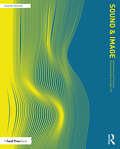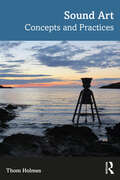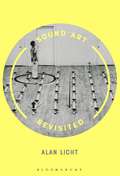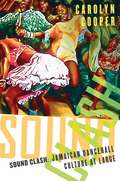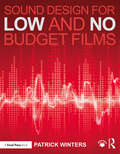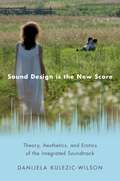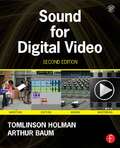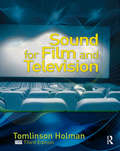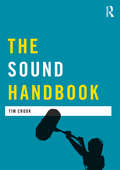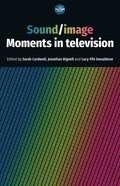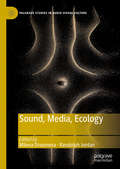- Table View
- List View
Sound and Image: Aesthetics and Practices (Sound Design)
by Andrew Knight-HillSound and Image: Aesthetics and Practices brings together international artist scholars to explore diverse sound and image practices, applying critical perspectives to interrogate and evaluate both the aesthetics and practices that underpin the audiovisual. Contributions draw upon established discourses in electroacoustic music, media art history, film studies, critical theory and dance; framing and critiquing these arguments within the context of diverse audiovisual practices. The volume’s interdisciplinary perspective contributes to the rich and evolving dialogue surrounding the audiovisual, demonstrating the value and significance of practice-informed theory, and theory derived from practice. The ideas and approaches explored within this book will find application in a wide range of contexts across the whole scope of audiovisuality, from visual music and experimental film, to narrative film and documentary, to live performance, sound design and into sonic art and electroacoustic music. This book is ideal for artists, composers and researchers investigating theoretical positions and compositional practices which bring together sound and image.
Sound and Image: Aesthetics and Practices (Sound Design)
by Andrew Knight-HillSound and Image: Aesthetics and Practices brings together international artist scholars to explore diverse sound and image practices, applying critical perspectives to interrogate and evaluate both the aesthetics and practices that underpin the audiovisual. Contributions draw upon established discourses in electroacoustic music, media art history, film studies, critical theory and dance; framing and critiquing these arguments within the context of diverse audiovisual practices. The volume’s interdisciplinary perspective contributes to the rich and evolving dialogue surrounding the audiovisual, demonstrating the value and significance of practice-informed theory, and theory derived from practice. The ideas and approaches explored within this book will find application in a wide range of contexts across the whole scope of audiovisuality, from visual music and experimental film, to narrative film and documentary, to live performance, sound design and into sonic art and electroacoustic music. This book is ideal for artists, composers and researchers investigating theoretical positions and compositional practices which bring together sound and image.
Sound and Music for the Theatre: The Art & Technique of Design
by Deena Kaye James LeBrechtCovering every phase of a theatrical production, this fourth edition of Sound and Music for the Theatre traces the process of sound design from initial concept through implementation in actual performances. The book discusses the early evolution of sound design and how it supports the play, from researching sources for music and effects, to negotiating a contract. It shows you how to organize the construction of the sound design elements, how the designer functions in a rehearsal, and how to set up and train an operator to run sound equipment. This instructive information is interspersed with ‘war stores’ describing real-life problems with solutions that you can apply in your own work, whether you’re a sound designer, composer, or sound operator.
Sound and Music for the Theatre: The Art & Technique of Design
by Deena Kaye James LeBrechtCovering every phase of a theatrical production, this fourth edition of Sound and Music for the Theatre traces the process of sound design from initial concept through implementation in actual performances. The book discusses the early evolution of sound design and how it supports the play, from researching sources for music and effects, to negotiating a contract. It shows you how to organize the construction of the sound design elements, how the designer functions in a rehearsal, and how to set up and train an operator to run sound equipment. This instructive information is interspersed with ‘war stores’ describing real-life problems with solutions that you can apply in your own work, whether you’re a sound designer, composer, or sound operator.
Sound Art: Concepts and Practices
by Thom HolmesSound Art offers the first comprehensive introduction to sound art written for undergraduate students. Bridging and blending aspects of the visual and sonic arts, modern sound art first emerged in the early 20th century and has grown into a thriving and varied field. In 13 thematic chapters, this book enables students to clearly grasp both the concepts behind this unique area of art, and its history and practice. Each chapter begins with an exploration of key ideas and theories, followed by an in-depth discussion of selected relevant works, both classic and current. Drawing on a broad, diverse range of examples, and firmly interdisciplinary, this book will be essential reading for anyone studying or teaching the theory, history, appreciation, or practice of sound art.
Sound Art: Concepts and Practices
by Thom HolmesSound Art offers the first comprehensive introduction to sound art written for undergraduate students. Bridging and blending aspects of the visual and sonic arts, modern sound art first emerged in the early 20th century and has grown into a thriving and varied field. In 13 thematic chapters, this book enables students to clearly grasp both the concepts behind this unique area of art, and its history and practice. Each chapter begins with an exploration of key ideas and theories, followed by an in-depth discussion of selected relevant works, both classic and current. Drawing on a broad, diverse range of examples, and firmly interdisciplinary, this book will be essential reading for anyone studying or teaching the theory, history, appreciation, or practice of sound art.
Sound Art Revisited
by Alan LichtThe first edition of Sound Art Revisited (published as Sound Art: Beyond Music, Between Categories) served as a groundbreaking work toward defining this emerging field, and this fully updated volume significantly expands the story to include current research since the book's initial release. Viewed through a lens of music and art histories rather than philosophical theory, it covers dozens of artists and works not found in any other book on the subject. Locating sound art's roots across the centuries from spatialized church music to the technological developments of radio, sound recording, and the telephone, the book traces the evolution of sound installations and sound sculpture, the rise of sound art exhibitions and galleries, and finally looks at the critical cross-pollination that marks some of the most important and challenging art with and about sound being produced today.
Sound Art Revisited
by Alan LichtThe first edition of Sound Art Revisited (published as Sound Art: Beyond Music, Between Categories) served as a groundbreaking work toward defining this emerging field, and this fully updated volume significantly expands the story to include current research since the book's initial release. Viewed through a lens of music and art histories rather than philosophical theory, it covers dozens of artists and works not found in any other book on the subject. Locating sound art's roots across the centuries from spatialized church music to the technological developments of radio, sound recording, and the telephone, the book traces the evolution of sound installations and sound sculpture, the rise of sound art exhibitions and galleries, and finally looks at the critical cross-pollination that marks some of the most important and challenging art with and about sound being produced today.
Sound Clash: Jamaican Dancehall Culture at Large
by C. CooperMegawattage sound systems have blasted the electronically-enhanced riddims and tongue-twisting lyrics of Jamaica's dancehall DJs across the globe. This high-energy raggamuffin music is often dismissed by old-school roots reggae fans as a raucous degeneration of classic Jamaican popular music. In this provocative study of dancehall culture, Cooper offers a sympathetic account of the philosophy of a wide range of dancehall DJs: Shabba Ranks, Lady Saw, Ninjaman, Capleton, Buju Banton, Anthony B and Apache Indian. Cooper also demonstrates the ways in which the language of dancehall culture, often devalued as mere 'noise,' articulates a complex understanding of the border clashes which characterize Jamaican society, and analyzes the sound clashes that erupt in the movement of Jamaican dancehall culture across national borders.
Sound Design for Low & No Budget Films
by Patrick WintersDon’t let your indie film be sabotaged by bad sound! One of the weakest technical aspects of a low or no budget short or feature film is usually the sound, and in Sound Design for Low and No Budget Films, author Patrick Winters explains what filmmakers need to do to fix that. Learn how to improve the sound quality of your low budget film with specific tools and practices for achieving a better sound track, including detailed, step-by-step explanations of how to edit your production track, create a sound design, record and edit ADR, Foley and sound effects, music, and much more. Focusing on the essential details indie filmmakers need to know, Winters teaches you how to turn a thin and distracting sound track into one that makes your film shine. This practical guide offers: • In-depth focus on hands-on, step-by-step instruction for achieving great sound in post-production, including recording and editing sound effects, ADR and Foley—even without expensive equipment and software. • Techniques specifically designed for low and no budget projects, perfect for both students and aspiring indie filmmakers. • A simple and direct style that any aspiring filmmaker or student can understand without already knowing the industry jargon.
Sound Design for Low & No Budget Films
by Patrick WintersDon’t let your indie film be sabotaged by bad sound! One of the weakest technical aspects of a low or no budget short or feature film is usually the sound, and in Sound Design for Low and No Budget Films, author Patrick Winters explains what filmmakers need to do to fix that. Learn how to improve the sound quality of your low budget film with specific tools and practices for achieving a better sound track, including detailed, step-by-step explanations of how to edit your production track, create a sound design, record and edit ADR, Foley and sound effects, music, and much more. Focusing on the essential details indie filmmakers need to know, Winters teaches you how to turn a thin and distracting sound track into one that makes your film shine. This practical guide offers: • In-depth focus on hands-on, step-by-step instruction for achieving great sound in post-production, including recording and editing sound effects, ADR and Foley—even without expensive equipment and software. • Techniques specifically designed for low and no budget projects, perfect for both students and aspiring indie filmmakers. • A simple and direct style that any aspiring filmmaker or student can understand without already knowing the industry jargon.
Sound Design is the New Score: Theory, Aesthetics, and Erotics of the Integrated Soundtrack (Oxford Music/Media Series)
by Danijela Kulezic-WilsonThe practice of blurring the line between score and sound design has transformed contemporary film soundscape by challenging not only the long-established hierarchical relationships between dialogue, music, and sound effects, but also the modes of perception shaped by classical soundtrack practices. The methods of this new trend rely on the language of contemporary popular and art music, producing soundtracks in which it is difficult to tell the difference between score and ambient sound, where pieces of electroacoustic music are merged with diegetic sound, sound effects are absorbed into the score or treated as music, and diegetic sound is treated as musique concrète. In Sound Design is the New Score, Kulezic-Wilson explores theoretical, aesthetic, and sensuous dimensions of this new trend, providing a multifaceted portrait of a practice which recognizes the interconnectedness of all soundtrack elements and emphasizes their inherent musicality. The aesthetic concerns of this practice are illuminated through the concept of the aesthetics of reticence which rejects classical narrative and scoring conventions and uses integrated soundtrack strategies to create the space for mystery in art and for individuality in the cinematic experience. The book's emphasis on sensuous and musical aspects of this practice, informed by the feminist discourse on the erotics of art, challenges popular notions about sensory cinema, demonstrating that the sensuousness of film form and its soundscapes is more sophisticated than simply being the result of excessive sensory stimulation facilitated by the use of digital technology or the "intensified" aesthetics it inspires. The discussion is supported by a wide range of case studies from American Independent, Asian, Australian, and European cinemas, including films by Shane Carruth, Claire Denis, Hou Hsiao-Hsien, Harmony Korine, David Michôd, Gus Van Sant, and Peter Strickland.
SOUND DESIGN IS THE NEW SCORE OMMS C: Theory, Aesthetics, and Erotics of the Integrated Soundtrack (Oxford Music/Media Series)
by Danijela Kulezic-WilsonThe practice of blurring the line between score and sound design has transformed contemporary film soundscape by challenging not only the long-established hierarchical relationships between dialogue, music, and sound effects, but also the modes of perception shaped by classical soundtrack practices. The methods of this new trend rely on the language of contemporary popular and art music, producing soundtracks in which it is difficult to tell the difference between score and ambient sound, where pieces of electroacoustic music are merged with diegetic sound, sound effects are absorbed into the score or treated as music, and diegetic sound is treated as musique concrète. In Sound Design is the New Score, Kulezic-Wilson explores theoretical, aesthetic, and sensuous dimensions of this new trend, providing a multifaceted portrait of a practice which recognizes the interconnectedness of all soundtrack elements and emphasizes their inherent musicality. The aesthetic concerns of this practice are illuminated through the concept of the aesthetics of reticence which rejects classical narrative and scoring conventions and uses integrated soundtrack strategies to create the space for mystery in art and for individuality in the cinematic experience. The book's emphasis on sensuous and musical aspects of this practice, informed by the feminist discourse on the erotics of art, challenges popular notions about sensory cinema, demonstrating that the sensuousness of film form and its soundscapes is more sophisticated than simply being the result of excessive sensory stimulation facilitated by the use of digital technology or the "intensified" aesthetics it inspires. The discussion is supported by a wide range of case studies from American Independent, Asian, Australian, and European cinemas, including films by Shane Carruth, Claire Denis, Hou Hsiao-Hsien, Harmony Korine, David Michôd, Gus Van Sant, and Peter Strickland.
Sound Effect: The Theatre We Hear (Performance and Design)
by Ross BrownSound Effect tells the story of the effect of theatrical aurality on modern culture. Beginning with the emergence of the modern scenic sound effect in the late 18th century, and ending with headphone theatre which brings theatre's auditorium into an intimate relationship with the audience's internal sonic space, the book relates contemporary questions of theatre sound design to a 250-year Western cultural history of hearing. It argues that while theatron was an instrument for seeing and theorizing, first a collective hearing, or audience is convened. Theatre begins with people entering an acoustemological apparatus that produces a way of hearing and of knowing. Once, this was a giant marble ear on a hillside, turned up to a cosmos whose inaudible music accounted for all. In modern times, theatre's auditorium, or instrument for hearing, has turned inwards on the people and their collective conversance in the sonic memes, tropes, clichés and picturesques that constitute a popular, fictional ontology.This is a study about drama, entertainment, modernity and the theatre of audibility. It addresses the cultural frames of resonance that inform our understanding of SOUND as the rubric of the world we experience through our ears. Ross Brown reveals how mythologies, pop-culture, art, commerce and audio, have shaped the audible world as a form of theatre. Garrick, De Loutherbourg, Brecht, Dracula, Jekyll, Hyde, Spike Milligan, John Lennon, James Bond, Scooby-Do and Edison make cameo appearances as Brown weaves together a history of modern hearing, with an argument that sound is a story, audibility has a dramaturgy, hearing is scenographic, and the auditoria of drama serve modern life as the organon, or definitive frame of reference, on the sonic world.
Sound Effect: The Theatre We Hear (Performance and Design)
by Ross BrownSound Effect tells the story of the effect of theatrical aurality on modern culture. Beginning with the emergence of the modern scenic sound effect in the late 18th century, and ending with headphone theatre which brings theatre's auditorium into an intimate relationship with the audience's internal sonic space, the book relates contemporary questions of theatre sound design to a 250-year Western cultural history of hearing. It argues that while theatron was an instrument for seeing and theorizing, first a collective hearing, or audience is convened. Theatre begins with people entering an acoustemological apparatus that produces a way of hearing and of knowing. Once, this was a giant marble ear on a hillside, turned up to a cosmos whose inaudible music accounted for all. In modern times, theatre's auditorium, or instrument for hearing, has turned inwards on the people and their collective conversance in the sonic memes, tropes, clichés and picturesques that constitute a popular, fictional ontology.This is a study about drama, entertainment, modernity and the theatre of audibility. It addresses the cultural frames of resonance that inform our understanding of SOUND as the rubric of the world we experience through our ears. Ross Brown reveals how mythologies, pop-culture, art, commerce and audio, have shaped the audible world as a form of theatre. Garrick, De Loutherbourg, Brecht, Dracula, Jekyll, Hyde, Spike Milligan, John Lennon, James Bond, Scooby-Do and Edison make cameo appearances as Brown weaves together a history of modern hearing, with an argument that sound is a story, audibility has a dramaturgy, hearing is scenographic, and the auditoria of drama serve modern life as the organon, or definitive frame of reference, on the sonic world.
Sound for Digital Video
by Tomlinson Holman Arthur BaumAchieve professional quality sound on a limited budget! Harness all new, Hollywood style audio techniques to bring your independent film and video productions to the next level. In Sound for Digital Video, Second Edition industry experts Tomlinson Holman and Arthur Baum give you the tools and knowledge to apply recent advances in audio capture, video recording, editing workflow, and mixing to your own film or video with stunning results. This fresh edition is chockfull of techniques, tricks, and workflow secrets that you can apply to your own projects from preproduction through postproduction. New to this edition: A new feature on "true" 24p shooting and editing systems, as well as single vs. double-system recording A strong focus on new media, including mini-DVDs, hard disks, memory cards, and standard and high-definition imagery Discussion of camera selection, manual level control, camera and recorder inputs, location scouting, and preproduction planning Instruction in connectors, real-time transfers, and file-based transfers from DVDs, hard drives, and solid state media. Blu-Ray and HD tape formats for mastering and distribution in addition to file-based, DV, and DVD masters. A revamped companion website, www.focalpress.com/cw/holman, featuring recording and editing exercises, examples and sample tracks Whether you are an amateur filmmaker who wants to create great sound or an advanced professional in need of a reference guide, Sound for Digital Video, Second Edition is an essential addition to your digital audio tool belt.
Sound for Digital Video
by Tomlinson Holman Arthur BaumAchieve professional quality sound on a limited budget! Harness all new, Hollywood style audio techniques to bring your independent film and video productions to the next level. In Sound for Digital Video, Second Edition industry experts Tomlinson Holman and Arthur Baum give you the tools and knowledge to apply recent advances in audio capture, video recording, editing workflow, and mixing to your own film or video with stunning results. This fresh edition is chockfull of techniques, tricks, and workflow secrets that you can apply to your own projects from preproduction through postproduction. New to this edition: A new feature on "true" 24p shooting and editing systems, as well as single vs. double-system recording A strong focus on new media, including mini-DVDs, hard disks, memory cards, and standard and high-definition imagery Discussion of camera selection, manual level control, camera and recorder inputs, location scouting, and preproduction planning Instruction in connectors, real-time transfers, and file-based transfers from DVDs, hard drives, and solid state media. Blu-Ray and HD tape formats for mastering and distribution in addition to file-based, DV, and DVD masters. A revamped companion website, www.focalpress.com/cw/holman, featuring recording and editing exercises, examples and sample tracks Whether you are an amateur filmmaker who wants to create great sound or an advanced professional in need of a reference guide, Sound for Digital Video, Second Edition is an essential addition to your digital audio tool belt.
Sound for Film and Television
by Tomlinson HolmanSound for Film and Television, Third Edition provides a thorough introduction to the fascinating field of recording, editing, mixing, and exhibiting film and television sound. It strikes a fine balance between aesthetic and technical content, combining theory and practice to approach sound as both an art and a science. This new edition has been completely updated to reflect the latest advances in HD technology, new hardware and software systems, new distribution methods, wireless sound capture, and more. Also, analog-related content has been reduced and transferred to the chapters covering historical techniques. Sections on troubleshooting and FAQs have been added to help you avoid common pitfalls in sound production. Written by one of Hollywood's leading sound experts, Sound for Film and Television provides a solid grounding in all aspects of the sound process. Basic principles are presented with illustrations demonstrating how they affect the day-to-day activities on a film or television set, in the editing room, and in the mix room. The accompanying audio DVD contains more than 50 tracks that demonstrate practical, real-world examples of key concepts presented in the book. A companion Web site provides further resources and information: http://booksite.focalpress.com/companion/Holman/SoundforFilmandTelevision/ Please use the access code located in the beginning of the book to register for access to the Web site.
Sound for Film and Television
by Tomlinson HolmanSound for Film and Television, Third Edition provides a thorough introduction to the fascinating field of recording, editing, mixing, and exhibiting film and television sound. It strikes a fine balance between aesthetic and technical content, combining theory and practice to approach sound as both an art and a science. This new edition has been completely updated to reflect the latest advances in HD technology, new hardware and software systems, new distribution methods, wireless sound capture, and more. Also, analog-related content has been reduced and transferred to the chapters covering historical techniques. Sections on troubleshooting and FAQs have been added to help you avoid common pitfalls in sound production. Written by one of Hollywood's leading sound experts, Sound for Film and Television provides a solid grounding in all aspects of the sound process. Basic principles are presented with illustrations demonstrating how they affect the day-to-day activities on a film or television set, in the editing room, and in the mix room. The accompanying audio DVD contains more than 50 tracks that demonstrate practical, real-world examples of key concepts presented in the book. A companion Web site provides further resources and information: http://booksite.focalpress.com/companion/Holman/SoundforFilmandTelevision/ Please use the access code located in the beginning of the book to register for access to the Web site.
The Sound Handbook
by Tim Crook'Tim Crook has written an important and much-needed book, and its arrival on our shelves has come at a highly appropriate time.' Professor Seán Street, Bournemouth University The Sound Handbook maps theoretical and practical connections between the creation and study of sound across the multi-media spectrum of film, radio, music, sound art, websites, animation and computer games entertainment, and stage theatre. Using an interdisciplinary approach Tim Crook explores the technologies, philosophies and cultural issues involved in making and experiencing sound, investigating soundscape debates and providing both intellectual and creative production information. The book covers the history, theory and practice of sound and includes practical production projects and a glossary of key terms. The Sound Handbook is supported by a companion website, signposted throughout the book, with further practical and theoretical resources dedicated to bridging the creation and study of sound across professional platforms and academic disciplines.
Sound / image: Moments in television (The Television Series)
by Jonathan Bignell Lucy Fife Donaldson Sarah CardwellAn exciting new strand in The Television Series, the ‘Moments in Television’ collections celebrate the power and artistry of television, whilst interrogating key critical concepts in television scholarship.Each ‘Moments’ book is organised around a provocative binary theme. Sound / image reassesses the synergy between televisual images, and sounds and music, as a key creative interaction warranting closer attention. Through close scrutiny of visual and sonic elements, the book’s chosen programmes are persuasively illuminated in new ways.The book explores an eclectic range of TV fictions, dramatic and comedic. Contributors from diverse perspectives come together to expand and enrich the kind of close analysis most commonly found in television aesthetics. Sustained, detailed programme analyses are sensitively framed within historical, technological, institutional, cultural, creative and art-historical contexts.
Sound / image: Moments in television (The Television Series)
by Jonathan Bignell Lucy Fife Donaldson Sarah CardwellAn exciting new strand in The Television Series, the ‘Moments in Television’ collections celebrate the power and artistry of television, whilst interrogating key critical concepts in television scholarship.Each ‘Moments’ book is organised around a provocative binary theme. Sound / image reassesses the synergy between televisual images, and sounds and music, as a key creative interaction warranting closer attention. Through close scrutiny of visual and sonic elements, the book’s chosen programmes are persuasively illuminated in new ways.The book explores an eclectic range of TV fictions, dramatic and comedic. Contributors from diverse perspectives come together to expand and enrich the kind of close analysis most commonly found in television aesthetics. Sustained, detailed programme analyses are sensitively framed within historical, technological, institutional, cultural, creative and art-historical contexts.
Sound, Lighting and Video: A Resource for Worship
by Brad HerringLights, Camera,Worship! is a manual for all of your technical needs. To draw people into your church with incredible worship experiences, you need to learn more about how to get the most from your lighting, sound, video, and projection systems. This is your one stop resource!Written by an experienced professional and consultant, this book will show you how to successfully run the major components that, done correctly, will make your church presentation the absolute best it can be and will draw more people in! This is packed with information that will not only show you how to use the technology, but how to troubleshoot and problem-solve in the areas you need it most from running a new control board to uniting your lighting and audio visual systems as one integrated unit. This won't just show you how to operate your systems - it will make your production go from OK to WOW!
Sound, Lighting and Video: A Resource for Worship
by Brad HerringLights, Camera,Worship! is a manual for all of your technical needs. To draw people into your church with incredible worship experiences, you need to learn more about how to get the most from your lighting, sound, video, and projection systems. This is your one stop resource!Written by an experienced professional and consultant, this book will show you how to successfully run the major components that, done correctly, will make your church presentation the absolute best it can be and will draw more people in! This is packed with information that will not only show you how to use the technology, but how to troubleshoot and problem-solve in the areas you need it most from running a new control board to uniting your lighting and audio visual systems as one integrated unit. This won't just show you how to operate your systems - it will make your production go from OK to WOW!
Sound, Media, Ecology (Palgrave Studies in Audio-Visual Culture)
by Milena Droumeva Randolph JordanThis volume reads the global urban environment through mediated sonic practices to put a contemporary spin on acoustic ecology’s investigations at the intersection of space, cultures, technology, and the senses. Acoustic ecology is an interdisciplinary framework from the 1970s for documenting, analyzing, and transforming sonic environments: an early model of the cross-boundary thinking and multi-modal practices now common across the digital humanities. With the recent emergence of sound studies and the expansion of “ecological” thinking, there is an increased urgency to re-discover and contemporize the acoustic ecology tradition. This book serves as a comprehensive investigation into the ways in which current scholars working with sound are re-inventing acoustic ecology across diverse fields, drawing on acoustic ecology’s focus on sensory experience, place, and applied research, as well as attendance to mediatized practices in sounded space. From sounding out the Anthropocene, to rethinking our auditory media landscapes, to exploring citizenship and community, this volume brings the original acoustic ecology problem set into the contemporary landscape of sound studies.
